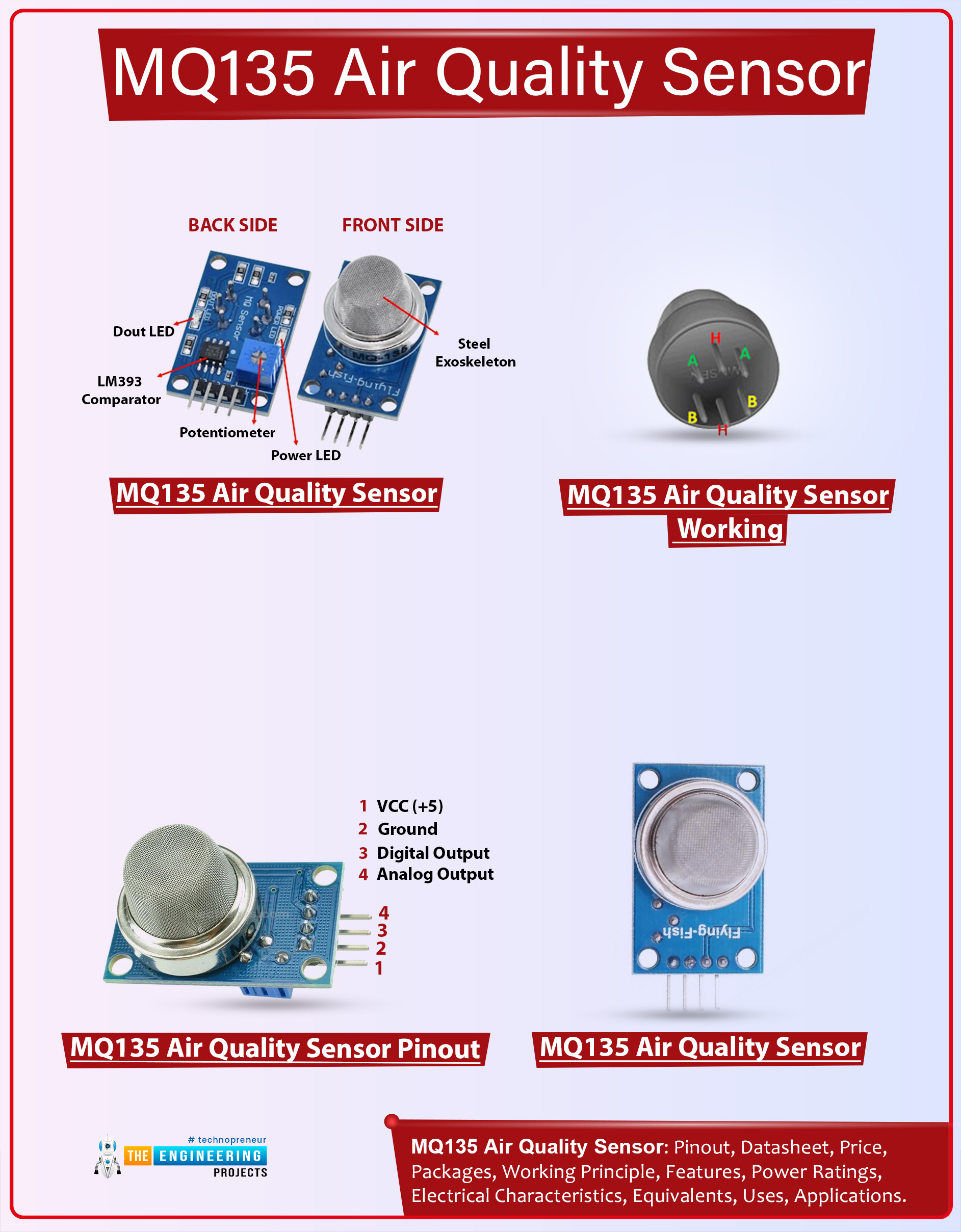
Hello students! I hope you are doing great. Today, I am going to share a reliable sensor that is widely used to sense the air quality in different types of projects and circuits. The increasing ratio of pollution in the air is alarming, and air quality monitoring systems are the need of the time. The MQ135 can detect and measure a wide range of gases around it and present the output in the form of digital or analogue values.
In this article, we will commence by providing a fundamental introduction to this sensor, outlining the target gases it is designed to detect. Following that, an exploration of the data sheet will be done through its essential elements, incorporating features, specifications, and other basic information. Subsequently, a detailed description of the sensor's working principle and physical dimensions will be presented to facilitate a comprehensive understanding. Finally, the article will conclude by moving towards the various applications where this sensor finds widespread usage. Let's embark on our discussion, beginning with the initial point:

MQ135 Air Quality Sensor Introduction
The MQ132 air quality sensor belongs to the MQ gas sensor series, and this does not stick to a single gas but can detect multiple gases at a time, thus contributing to detecting the overall air quality. It operates on 5V and has the feature to set the threshold value, so whenever the air pollutant crosses a certain limit, it sends the signal to its digital pin, which can be used to set the alarm. Moreover, the continuous signal of the air quality values is sent to the analogue pin.

Unlike many other sensors from the MQ series, it is sensitive to multiple gases, and these are mentioned below:
Ammonia (NH3)
Sulfur (S)
Benzene (C6H6)
CO2
NOx
Smoke
The list does not end here; many other harmful gases are detected with this sensor that may cause issues like lung disease, eye infections, and others, but timely detection of these gases can save lives.
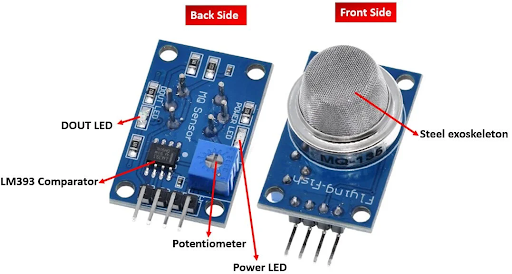
MQ135 Air Quality Sensor Datasheet
A datasheet for any device holds beneficial information and is a prerequisite before choosing any device. I’ve collected some important information from the datasheet that is given below:
MQ135 Air Quality Sensor Features
It is highly sensitive to a large number of toxic gases that are more likely to be mixed in the air. Some examples are NH3, NOx, CO2, benzene, smoke, etc., which are common air pollutants.
It is a small sensor, and the design is simple, therefore, it is less expensive.
It is a low-power sensor.
Some modules have a power LED that indicates the power mode.
It is an easy-to-use sensor.
MQ135 Air Quality Sensor Specifications
The following table will justify the general specifications of this sensor:
Property |
Value |
Model |
MQ135Sensor |
Type |
SemiconductorStandard |
Encapsulation |
Bakelite, Metal cap |
Target Gas |
ammonia gas, sulfide, benzene series steam |
Detection range |
10~1000ppm( ammonia gas, toluene, hydrogen, smoke) |
Standard Circuit Conditions |
Loop VoltageVc5.0V±0.1V DC Heater VoltageVH5.0V±0.1V AC or DC Load resistanceRLAdjustable |
Sensor character under standard test conditions |
Heater ResistanceRH30Ω±3Ω (room temp.) Heater consumptionPH≤950mW SensitivitySRs(in air)/Rs(in 400ppm H2)≥5 Output VoltageVs2.0V~4.0V(in 400ppm H2) Concentration Slopeα≤0.6(R400ppm/R100ppmH2) |
Standard test conditions |
Tem. Humidity20℃±2℃;55%±5%RH |
Standard test circuit |
Vc:5.0V±0.1V; VH: 5.0V±0.1V |
Preheat time |
Over 48 hours |
Oxygen content |
21% (not less than 18%), O2 concentration affects initial value, sensitivity, and repeatability. |
MQ135 Air Quality Sensor Basic Structure
As mentioned in the features, the MQ135 has a simple structure that makes it an ideal choice for different types of projects. Here is the basic circuit diagram that justifies this statement:
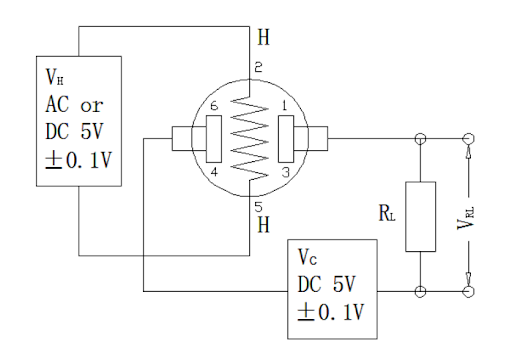
Here,
RH= The resistor that provides heat to the circuit.
RL = The load resistor that is connected in series with the circuit. It limits the current flowing through the circuit.
Vc = It is one of the voltage sources, and this label indicates the DC voltage.
VH= it is another source voltage but this can be either AC or DC.
MQ135 Air Quality Sensor Sensitivity Curve
The MQ135 can detect multiple gases, but the sensitivity of these gases is not identical. This depends on the speed of the chemical reaction taking place with the sensing element. Based on multiple experiments, experts have designed the following sensitivity curve graph for users:
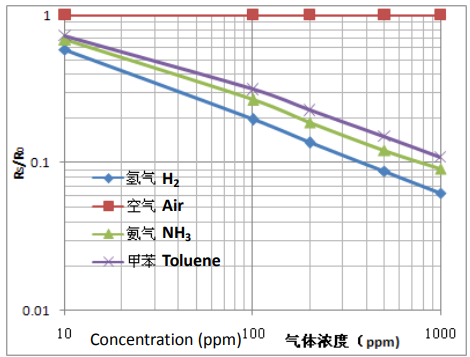
The above graph shows the sensitivity of the hydrogen, ammonia, toluene, and fresh air by keeping other parameters constant.
MQ135 Air Quality Sensor Temperature/Humidity Characteristics
The external parameters of the sensor affect its working and it shows a slightly different behaviour. Here is the diagram that shows the performance graph of the MQ135 air quality sensor at varying humidity and temperature:
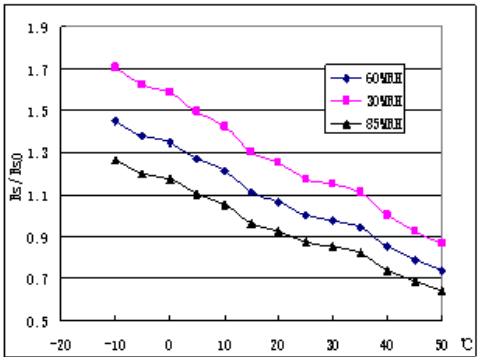
The different lines show the performance of the sensor for the same gas at different humidity and temperature levels in the air.
If you want to know more details about the MQ135 sensor datasheet, you must visit the following link:
MQ135 Air Quality Sensor Pinout Configuration
Based on its structure, I’ve created the table that explains the pinout configuration of MQ135, which is given below:
Pin |
Label |
Description |
1 |
H (VCC, VDD) |
Heater Voltage |
2 |
GND |
Ground |
3 |
A (D0, OUT) |
Analog Output |
4 |
B (D1, S) |
Optional: Digital Output (consult datasheet) |
The pinout may be slightly vary depending on the model of the sensor.
MQ135 Air Quality Sensor Packages
The MQ series is present in different packages for the convenience of the user. Here is a small description that shows the available packages for MQ135 and their features:
Package Type |
Description |
Standard TO-18 |
|
Board-mounted |
|
MQ135 Air Quality Sensor Alternatives
The MQ series has multiple sensors that can detect the same gases as the QM135 does, but the difference is, that the MQ135 can detect multiple gases at a time. Other members of the series can be used as an alternative to MQ135; if you want to learn about other sensor series that can be used in place of MQ135, here are some options for you:
Sensor |
Target Gases |
Applications |
Features |
MQ2 |
Multiple gases |
General gas detection |
A broad range of gas detection |
MQ3 |
Alcohol, ethanol, smoke |
Breathalyzers, smoke detectors |
Suitable for detecting combustible gases |
MQ7 |
Carbon monoxide, methane |
Indoor air quality monitoring |
Detects common indoor air pollutants |
MQ8 |
Hydrogen, other gases |
Gas leakage detection systems |
Sensitive to hydrogen leaks |
MQ9 |
Carbon monoxide, methane, LPG |
Domestic gas leakage detection |
Detects various flammable gases |
CCS811 |
CO2, TVOC |
Indoor air quality monitoring |
Measures CO2 and total volatile organic compounds |
MiCS-5524 |
CO, methane, LPG, smoke |
Indoor air quality and gas leakage monitoring |
Multi-gas detection for safety applications |
MH-Z19 |
Carbon dioxide (CO2) |
Precise CO2 level measurement |
Accurate detection of CO2 concentration |
Winsen ZE03 |
CO, H2S, CH4 |
Specific gas detection |
Electrochemical sensor for targeted gas detection |
SGP30 |
TVOC, eCO2 |
Measures total volatile organic compounds and CO2 equivalent |
Detects various indoor air pollutants |
Where to Buy ABC MQ135 Air Quality Sensor
It is important to buy sensitive devices like the MQ135 from a reliable source. For this, we have created a list of the platforms to buy the best devices, including the MQ135:
eBay
AliExpress
Amazon
MQ135 Air Quality Sensor Working Principle
The simple structure of MQ135 is responsible for its ease of use and great performance. The working principle of this sensor can be understood with the help of the following steps:
MQ135 Air Quality Sensor Pre-heating
As soon as the sensor is turned on, it has to be preheated. This is done with the heating circuit of the sensor. It takes 20-30 seconds to reach a temperature of 300°C. Once this temperature is gained, it works on maintaining this temperature as long as it has the power.
MQ135 Air Quality Sensor Sensitivity Layer
The heating mechanism stimulates the sensing element to absorb the oxygen from the air surrounding it. The sensing element is made with tin dioxide that, when it absorbs the oxygen, has a sensing layer on its surface. This happens only for a certain limit because the accumulation of atoms on the surface creates a layer around it. This is the reason why tin oxide has a high electrical resistance in pure air. At this level, the sensing layer has limited availability of free electrons to react with the external pure air.
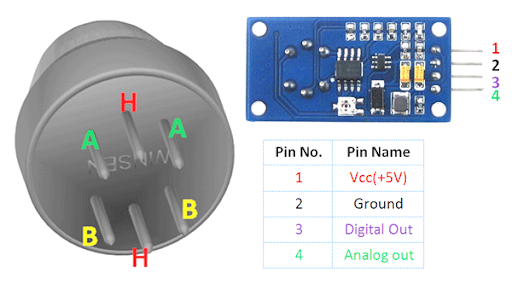
MQ135 Air Quality Sensor Gas Interaction
Whenever the target gas (smoke or ammonia) is present in the air, the gas molecules are absorbed by the atoms of the sensing element, and this reaction results in the absorption of this layer. As a result, the electrical conductance of the sensing element increases, and these values are indicated through the analogue data at the analogue pin.
MQ135 Air Quality Sensor Output
The greater the target gas concentration in the surrounding area, the greater the analogue values. The whole circuit is designed in such a way that the analogue pins send the data to the output device for the indication of this change.
Some models of the MQ135 have a digital pin that shows the presence of gas only when values reach the pre-set threshold limit. The digital pin then sends the signal to the output device.
MQ135 Air Quality Sensor Physical Dimensions
The physical dimensions of this sensor may vary from package to package but I’ve created a table for you that generally describes it:
Package Type |
Diameter (mm) |
Height (mm) |
Standard TO-18 |
20-22 |
18-22 |
Board-mounted |
Varies (typically larger) |
Varies (typically taller due to additional components) |
MQ135 Air Quality Sensor Applications
Because of its multiple gas detection capabilities, this sensor can be utilized in multiple types of projects. The general list of some important and commonly used terms is given below:
Domestic gas leak detection
Indoor air quality monitoring
Industrial air quality monitoring
Smart home appliances (air purifiers, ventilation systems)
Portable air quality detectors
Automotive applications (emissions, in-cabin air quality)
I hope I have covered all the points that you were searching for. I started with the basic introduction and then moved forward with the datasheet elements of this sensor. We also saw the features, specifications, and working principle in detail and in the end, we say the physical dimension and its applications in different fields of life. I hope it was helpful for you and if you ant to ask more, you can contact us in the comment section.



